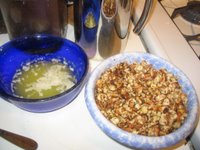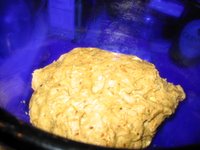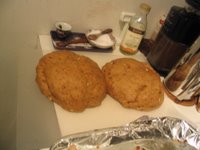Tuesday, January 09, 2007
Paprika Rice Supper with Pork Carnitas
Paprika Rice Supper with Pork Carnitas
2 tablespoons Smoked Spanish Paprika
2 teaspoons whole Allspice
1 teaspoon Black Pepper
1 1/2 teaspoons Dried Oregano
3 tablespoons Cider Vinegar
7 cloves Garlic, peeled
1/2 teaspoon Kosher Salt, or to taste
1 - 2 pounds Boneless Pork Shoulder, trimmed and cut int 1 1/2-inch cubes
1 tablespoon Lemon juice, freshly squeezed
1 Anaheim Chile, fresh
1 cup frozen Peas, defrosted
1 cup Spanish Rice
1 Yellow Onion, finely chopped
1 3/4 cups Beef Broth
2 Carrots, chopped (I used Yellow and Purple Carrots from the Greenmarket)
Italian Parsley, chopped, as a garnish (optional)
With a mortar and pestle, grind and mix well Paprika, Allspice, Pepper, Oregano, Vinegar, Garlic and Salt (it is easier to give garlic a pastelike consistency if ground together with Kosher Salt). Add water (around 1 tablespoon) to make a thick paste. Spoon into a bowl and set aside.
Place Pork in a large, heavy-bottomed saucepan. Cover with water by 1/2-inch. Add Lime Juice and pinch of Kosher Salt. Simmer, partially covered, on medium heat, for 1 - 1 1/2 hours; until the pork is frying in its own fat and no other liquid remains. (As you near the end of the cooking time, watch the pot carefully so you don't wind up with a nasty burned mess like I did.) Reduce heat and, uncovered, brown meat, turning frequently, for about 10 minutes. With a slotted spoon, remove meat. I only had a thin veneer of fat left--perfect to cook the rice in. If you have too much fat remaining, feel free to empty some of it out.
Meanwhile, pre-heat broiler and, when hot, place Chile inside and roast, turning every few minutes, until blackened on all sides. Remove, wrap in a kitchen towel and, when cool, peel off blistered skin, cut in half lengthwise, remove and discard seeds, and dice Chile.
Return Carnitas saucepan (with a thin layer of fat on the bottom) to the stove over medium heat and add Rice and Onion. Cook, about 5 minutes, stirring regularly, until Onion is soft and Rice no longer translucent. While Rice and Onion cook, heat Broth in a small saucepan. Stir in Paprika paste (2 tablespoons, or to taste) and Salt, if needed. Mix well. When Rice and Onion are ready, add Broth mixture, along with Pork, Chile and Carrots. Stir once, scrape down sides of pot, then cover and cook over medium-low heat until Rice is nearly cooked through--about 15 minutes. Turn off heat, stir in Peas and re-cover, then let stand another 5 minutes or so, until Rice is cooked through. Fluff Rice and serve, sprinkled with chopped Parsley.
Food and Cooking and Recipe and Paprika and Fusion and Meat and Pork
Monday, December 25, 2006
Happy Holidays
"Merry Christmas to all, and to all a good night."
--Tiny Tim.
Friday, December 01, 2006
Pain de biere, d'amandes et de gingembre

I suppose I'll just stop saying I'm not a baker, since I do keep on baking. However, aside from my Focaccia in May I've never made Bread before and, I have to admit, I'm still scared of Yeast. After all, it is bacteria and alive. Pretty Spooky.
Anyway, I had read that Beer Bread is one of the easiest breads to make, so I decided to give it a shot. I was feeling a little under the weather, which always makes me want to create something from scratch, something that will be completely different when I take it out of the oven from how it was when I put it in. Of course, baking is the best solution to all of these requirements.
Although most beer breads don't require yeast, the one I decided to make, Almond Ginger Beer Bread, which I found on CDKitchen.com, did. Nevertheless, the Bread turned out perfectly, with a soft crumb and very little crust. I don't know how much of a difference the beer used makes, but, since I only like dark ales, I decided to make the Bread with Guinness. I was really pleased with the result. There was a definite dark beer under flavor but even Mom, who doesn't like bread, loved it. I also added some Caraway Seeds to give it a slight hint of Rye Bread. Next time I would probably add a little more Ginger and Caraway Seeds to enhance their flavors. It was also faintly sweet and fantastic toasted with a little salted butter for breakfast.
Pain de biere, d'amandes et de gingembre
2 cups Almonds, chopped
2 tablespoons + 4 tablespoons Butter
1 1/2 cups Guinness
1/2 cup Brown Sugar
1 package Active Dry Yeast
4 cups All-Purpose Flour
2 teaspoons Ground Ginger
1 teaspoon Caraway Seeds
2 Eggs
1/2 tablespoon Kosher Salt, or to taste
1/2 teaspoon Almond Extract
1 tablespoon Water
Olive Oil, as needed
 Pre-heat oven to 350 F. Saute Almonds in 2 tablespoons Butter until crispy; set aside. Melt remaining 4 tablespoons Butter, taking care it doesn't burn. Pour into a bowl and reserve.
Pre-heat oven to 350 F. Saute Almonds in 2 tablespoons Butter until crispy; set aside. Melt remaining 4 tablespoons Butter, taking care it doesn't burn. Pour into a bowl and reserve.
Stir together Guiness and Brown Sugar. Mix in Active Dry Yeast and let stand until fully dissolved, 10 minutes.
and let stand until fully dissolved, 10 minutes.
Beat in 2 cups Flour, Ginger, 1 Egg,  Salt and Almond Extract. Add reserved Melted Butter and sprinkle on 3rd cup of Flour. Stir in Sauteed Almonds. Begin to knead dough in bowl, adding more Flour as needed, until the bowl is clean and the dough firm.
Salt and Almond Extract. Add reserved Melted Butter and sprinkle on 3rd cup of Flour. Stir in Sauteed Almonds. Begin to knead dough in bowl, adding more Flour as needed, until the bowl is clean and the dough firm.
Place dough in food processor with dough hook, add a little flour if necessary, and knead about 10 minutes, until dough is smooth and elastic. Rub oil in the large bowl and place dough inside. Turn dough around inside bowl to coat it well with oil. Cover with a clean dishtowel and let it sit until double in volume, about 1 hour. Punch dough down and let rest 10 minutes. Divide in half and, on a clean board, form 2 round loaves. Place on baking sheet, cover with towel and let rise again until double in volume, another hour.
necessary, and knead about 10 minutes, until dough is smooth and elastic. Rub oil in the large bowl and place dough inside. Turn dough around inside bowl to coat it well with oil. Cover with a clean dishtowel and let it sit until double in volume, about 1 hour. Punch dough down and let rest 10 minutes. Divide in half and, on a clean board, form 2 round loaves. Place on baking sheet, cover with towel and let rise again until double in volume, another hour.
 Beat 2nd Egg with Water and brush loaves with mixture. This will give a shiny crust to your bread. Bake for about 30 minutes, until bread is golden brown and sounds hollow when tapped on the bottom.
Beat 2nd Egg with Water and brush loaves with mixture. This will give a shiny crust to your bread. Bake for about 30 minutes, until bread is golden brown and sounds hollow when tapped on the bottom.
Makes 2 loaves.
Food and Baking and Recipe and Bread and Vegetarian and Dairy
Wednesday, October 18, 2006
Le nouveau arrive: Ozzy
 As you have probably guessed, the reason that I have been rather delinquent in my blogging is that I have a new puppy who takes up a TON of time, leaving very little for interesting cooking , much less blogging. But we love Ozzy and are so happy to welcome him into our lives.
As you have probably guessed, the reason that I have been rather delinquent in my blogging is that I have a new puppy who takes up a TON of time, leaving very little for interesting cooking , much less blogging. But we love Ozzy and are so happy to welcome him into our lives.Ozzy is an eight-month-old Pekingese and we've had him for about a month. We adopted him and brought him home on the second day of Rosh Hashanah, which I think is an excellent omen for the coming year. We adopted him from C.A.R.E. an animal adoption agency who houses the animals out in Bayonne, NJ. Ozzy was bought from a pet store by an older man who soon realized he was too old to take care of a puppy and abandoned Ozzy at a shelter. Poor baby! When we first adopted him, he was shy but still very loving and trusting. Now he acts as if he owns our apartment, barking at any interlopers! He still loves cuddling, often curling up in my arms whenever I do work. He loves playing, his new favorite toy being a rope toy, though he also loves a ratty old tennis ball he found under our bed. He is very sweet and friendly and we are so blessed to have him.
If you are planning on getting a pet (which I can't recommend enough), may I suggest you adopt a rescue animal? Shelters are no place for animals to live, devoid of affection, and there are so many sweet animals just waiting for someone to fall in love with them and take them home. My last dog, Blueberry, was also a rescue dog and there is nothing like watching a puppy learn to trust and love you. You become a real savior for him/her and, as long as you return that love, you will be handsomely rewarded.
This is the fantastic website through which I found Ozzy:
Petfinder.
Regular food blogging will resume shortly. As well as participation in WDB. Yay!
Interlude and Dog and Pekingese and puppy and Adoption
Tuesday, September 12, 2006
Soupe d'ete

One of my favorite things about blogging is discovering new blogs with recipes I never would have dreamed of. If you're very observant, you might have noticed that I've added a new blog to my blogroll, Farmgirl Fare, written by Susan, who lives on a farm in Missouri. Needless to say, many of her recipes are based around fresh produce that she grows herself on her farm. One recipe that really caught my eye was this beautiful Soup. She made it to use up all her extra summer produce. Since I, unfortunately, do not have that problem living in the city, I used the recipe as an excuse to check out what looked most atrractive at the Greenmarket. I also swirled a dollop of my Pesto into the soup to brighten it up.
I stayed as close to Susan's recipe as I could, but, needless to say, I did make a few small changes. So here is my version:
Soupe d'ete
2 tablespoons Olive Oil
2 Yellow Onions, roughly chopped
4 Red Peppers, roughly chopped
2 Zucchini, roughly chopped
2 Yellow Crookneck Squash, roughly chopped
6 cups Chicken Stock
1/8 teaspoon Kosher Salt and Pepper, or to taste
Heat Olive Oil in a large pot. Add Onions, Peppers, Zucchini and Squash. Cook for about 10 minutes, mixing the vegetables around so they cook evenly and are covered with Oil. Add Chicken Stock and boil. Reduce heat and simmer, with lid cracked, until vegetables can be cut with a wooden spoon, about 15 minutes. Add Salt and Pepper. Using an immersion blender, puree soup. Serve plain or with Pesto swirled in.
Food and Cooking and Recipe and Soup and Summer and Meat
Wednesday, September 06, 2006
Pesto d'ete
 Labor day has passed and, with it, the accepted, if not astrological, end of summer. So, to commemorate all that beautiful summer bounty we were blessed with the past three months, I decided to make a Pesto. Pesto is very popular in the blogosphere during the summer. It is probably one of the easiest pasta sauces and perfect for summer for several reasons. First of all, it relies on an herb (usually Basil) as its main ingredient. For the Pesto to be superb, the Basil must be as well. And, although Pesto is traditionally made in a mortar and pestle, I made mine in the food processor, which meant I didn't heat up the kitchen except to boil water for the Pasta. Of course, Pesto is also wonderful served cold.
Labor day has passed and, with it, the accepted, if not astrological, end of summer. So, to commemorate all that beautiful summer bounty we were blessed with the past three months, I decided to make a Pesto. Pesto is very popular in the blogosphere during the summer. It is probably one of the easiest pasta sauces and perfect for summer for several reasons. First of all, it relies on an herb (usually Basil) as its main ingredient. For the Pesto to be superb, the Basil must be as well. And, although Pesto is traditionally made in a mortar and pestle, I made mine in the food processor, which meant I didn't heat up the kitchen except to boil water for the Pasta. Of course, Pesto is also wonderful served cold. Because this was my first time making Pesto (shocking, I know, especially since we're such big pasta eaters), I made a pretty basic one, using my book Garlic, Garlic, Garlic for inspiration. I only made a couple of changes, must notably using fresh Garlic instead of dried. Some people have found raw garlic too strong i pesto and I found the fresh garlic to be a perfect alternative. I also substituted Walnuts for the more common Pine Nuts.
Pesto d'ete
3 cups Basil Leaves
1 cup Italian Parsley
8 cloves Fresh Garlic
1 cup Parmesan Cheese, coarsely grated
4 tablespoons Unsalted Butter
Black Pepper, about 8 grinds
pinch dried Oregano
Fleur de Sel, about 4 pinches
1/2 cup Walnuts
2/3 cup good-quality Extra Virgin Olive Oil
Combine Basil, Parsley, Garlic, Cheese, Butter, Pepper, Oregano and Fleur de Sel in a food processor. Pulse until finely chopped and pasty (pulsing gives you more control). Add Walnuts, broken in half, and pulse/chop until all walnut pieces are of a consistent size. Dribble in Oil, keeping the food processor running the whole time. Scrape sides and blend again until the mixture looks/feels like pesto (thick and rather creamy).
Add to pasta, grilled chicken, grilled fish--whatever you want!
Food and Cooking and Recipe and Pesto and Summer and Vegetarian and Dairy
Thursday, August 24, 2006
Canard roti au miel
Why do Friday nights require this magic, you might ask? Two reasons. First--the Boy has started his second year of law school, so he has classes during the week and Friday nights he has no homework but, instead, can lounge around lazily and then (hopefully!) help me with the dishes. Second--Friday night is when Shabbos begins and, even though I usually have to work on Saturdays, I like to at least rest Friday nights and celebrate the weekly holiday with some kind of special meal. Traditionally Shabbos dinner means meat but, just as often, we serve fish. As far as I'm concerned, as long as it feels special, and there's a good bottle of wine, you're set.
Last Friday, I was off from work and decided to roast a whole duck which, I knew, takes a long time. In France, I fell in love with Magret de canard au miel, duck breast with honey, and have not yet been able to re-create that. So, instead, I basted my roasting whole duck with a honey sauce and it came out deliciously. I used a rather strong honey to stand up to the rich, dark duck meat. Next time, I would use even more sauce.
Canard roti au miel
Leaves of 2 stalks Basil, roughly torn
1 teaspoon Ginger Root, roughly chopped
2 pinches Kosher Salt, or to taste
1/4 cup strong, dark Honey (I used a Miel des Garrigues, from France)
1/4 stick Unsalted Butter, room temperature
1/8 cup Orange Juice
Juice from 1/2 Lemon
1 pinch dry Mustard
1 whole Duck, giblets removed
Pre-heat oven to 400 F. In mortar and pestle, pound together Basil, Ginger and Salt until pasty. In a saucepan over medium-low heat, stir together Honey, Butter, Orange Juice, Lemon Juice and Mustard until Butter is melted and ingredients well-combined. Boil for about 3 minutes. Clean out cavity of Duck and pat dry with paper towels. If desired, cut/tear off any excess fat from carcass, even pulling out some of the fat under the skin with your fingers. Prick outside of Duck all over with a sharp knife. This will help drain the fat as the Duck cooks. Rub Basil mixture evenly into cavity.
Place Duck in roasting pan, breast-side up, preferably with a rack so the juices and fat can drip down as the Duck cooks. Pour half of Honey mixture over Duck, reserving the rest. Cover with tinfoil and roast for 30 minutes. Reduce heat to 350 F, turn Duck breast-side down, spoon on more Honey, re-cover and roast, basting every half-hour with the honey, for 2 hours. Uncover, turn Duck breast-side up, pour on remaining Honey and roast for 30 minutes. This allows the skin to brown and become crisp.
Allow to rest before carving.
Food and Cooking and Recipe and Duck and Meat
